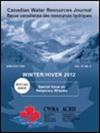Towards a better understanding of the evaporative cooling of rivers: case study for the Little Southwest Miramichi River (New Brunswick, Canada)
IF 1.7
4区 环境科学与生态学
Q3 WATER RESOURCES
引用次数: 2
Abstract
Abstract Stream temperature plays an important role in many biotic and abiotic processes, as it influences many physical, chemical, and biological properties in rivers. As such, a good understanding of the thermal regime of rivers is essential for effective fisheries management and the protection of aquatic habitats. Moreover, a thorough understanding of underlying physical processes and river heat fluxes is essential in developing better and more adaptive water temperature models. Very few studies have quantified river evaporation and rivers’ corresponding evaporative cooling component. The present study investigated the evaporative cooling of the Little Southwest Miramichi River in Eastern Canada by calculating the evaporative heat flux and overall heat fluxes using in-situ data. Results showed that the evaporative heat flux reached −300 W m−2 mid-day when high water temperatures were observed. The daily evaporative heat flux can thus account for close to 50% of the total heat losses, followed by longwave radiation (25%), streambed heat fluxes (20%), and sensible heat (5%). Our results show that the evaporative heat flux can be a critical cooling mechanism for wide and shallow rivers during high summer temperatures.更好地理解河流的蒸发冷却:以小西南米拉米奇河(加拿大新不伦瑞克省)为例
摘要河流温度在许多生物和非生物过程中起着重要作用,因为它影响河流的许多物理、化学和生物特性。因此,充分了解河流的热状况对于有效的渔业管理和保护水生栖息地至关重要。此外,深入了解潜在的物理过程和河流热通量对于开发更好、更具适应性的水温模型至关重要。很少有研究量化了河流蒸发和河流相应的蒸发冷却成分。本研究通过使用现场数据计算蒸发热通量和总热通量,研究了加拿大东部小西南米拉米奇河的蒸发冷却。结果表明,蒸发热通量达到−300 W m−2,此时观测到高水温。因此,日蒸发热通量可占总热损失的近50%,其次是长波辐射(25%)、河床热通量(20%)和显热(5%)。我们的研究结果表明,在夏季高温期间,蒸发热通量可能是宽浅河流的关键冷却机制。
本文章由计算机程序翻译,如有差异,请以英文原文为准。
求助全文
约1分钟内获得全文
求助全文
来源期刊

Canadian Water Resources Journal
WATER RESOURCES-
CiteScore
2.90
自引率
5.90%
发文量
17
审稿时长
>12 weeks
期刊介绍:
The Canadian Water Resources Journal accepts manuscripts in English or French and publishes abstracts in both official languages. Preference is given to manuscripts focusing on science and policy aspects of Canadian water management. Specifically, manuscripts should stimulate public awareness and understanding of Canada''s water resources, encourage recognition of the high priority of water as a resource, and provide new or increased knowledge on some aspect of Canada''s water.
The Canadian Water Resources Journal was first published in the fall of 1976 and it has grown in stature to be recognized as a quality and important publication in the water resources field.
 求助内容:
求助内容: 应助结果提醒方式:
应助结果提醒方式:


